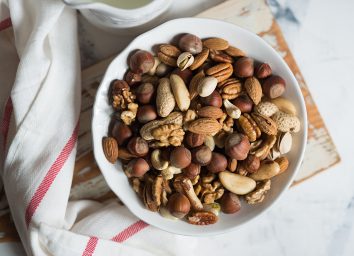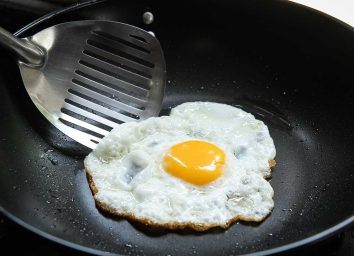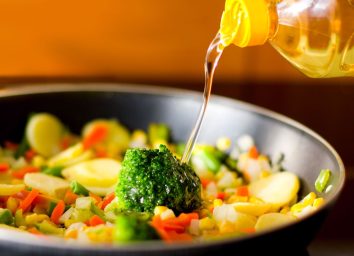How To Extract the Most Nutrients From Your Food
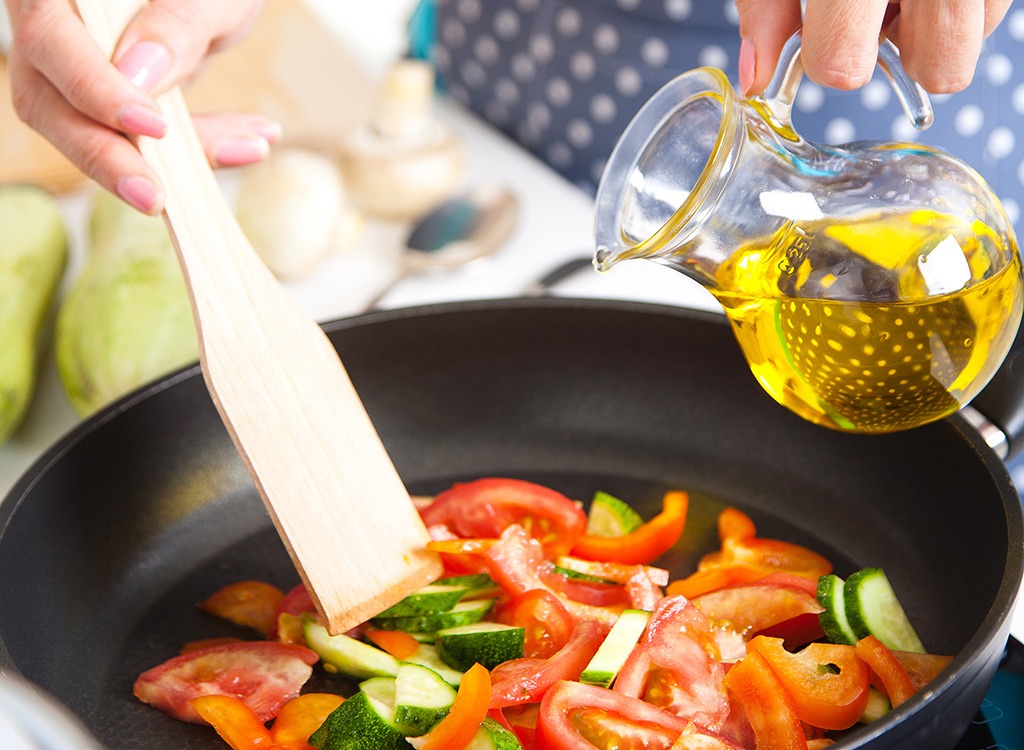
Would you pour out a third of your bottle of wine before you even have a sip?
We didn't think so. Well, the same goes for food prep. Just because you're whipping up a dish with a healthy ingredient doesn't mean you're getting all the benefits you possibly can from it. The way you choose to prepare, pair, and cook your food influences its amount of available nutrients. For example, when you boil spinach, its levels of vitamin C decrease by 35 percent compared to when you eat it raw. That's because heat and water can destroy some of the vitamins in veggies—particularly water-soluble vitamin C, B vitamins like folate, and potassium.
On the other hand, some studies actually suggest that certain foods benefit from a little fire. If this is the case, it's because heat facilitates the release of antioxidants by breaking down cell walls, making it easier for your body to absorb these compounds. It's not just cooking method that influences nutrition—it can also be how you process or cut up a food and even what you pair that food with when you eat it.
Before you get overwhelmed, take heart in that there are a handful of simple steps you can take in the kitchen to boost your foods' health potential—without sacrificing flavor. Here's a roundup of the methods you need to know: science-proven secrets that make already good-for-you ingredients even better and more likely to pass along their flat-belly benefits.
How to Cook
Tomatoes: Crush and Cook
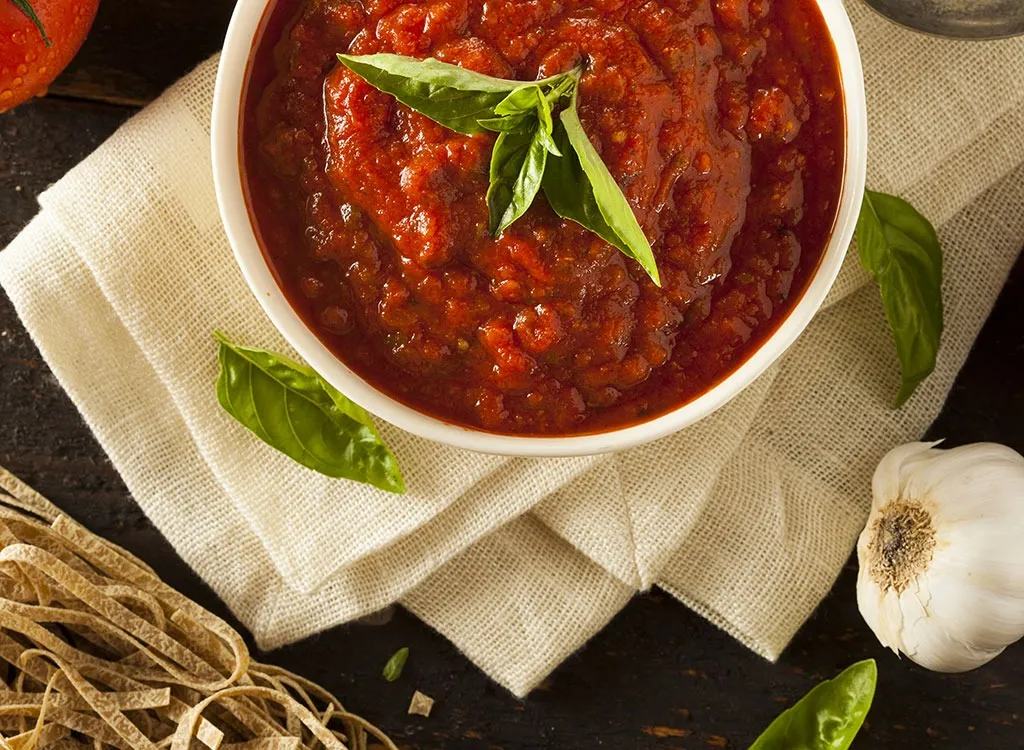
Turn up the heat on red tomatoes to give these fruit some added disease-fighting power. That's because cooking substantially raises the levels of a beneficial compound called lycopene—a carotenoid responsible for tomatoes' red color shown to decrease cancer and perhaps even protect the skin from UV light by mopping up disease-causing free radicals (it's what makes them a great food to get you bikini ready). The heat induces a change in structure of the lycopene, converting it into a "bioavailable" configuration that is more readily absorbed by our bodies. Another way of unleashing the absorbable power of lycopene is to process the tomatoes. This process could involve crushing them (like you see in crushed, canned tomatoes) or turning them into tomato paste.
Eat This! Tip:
The longer the cooking the time, the better. A clinical trial conducted by Ohio State University showed that people had 55 percent more lycopene in their blood after eating a specially processed tomato sauce that underwent a second-round of cooking for 40 minutes than they did after eating regular red tomato sauce.
The same goes for: Lycopene-rich foods like sweet red peppers, asparagus, purple cabbage, and carrots
Broccoli: Lightly Steam and Season
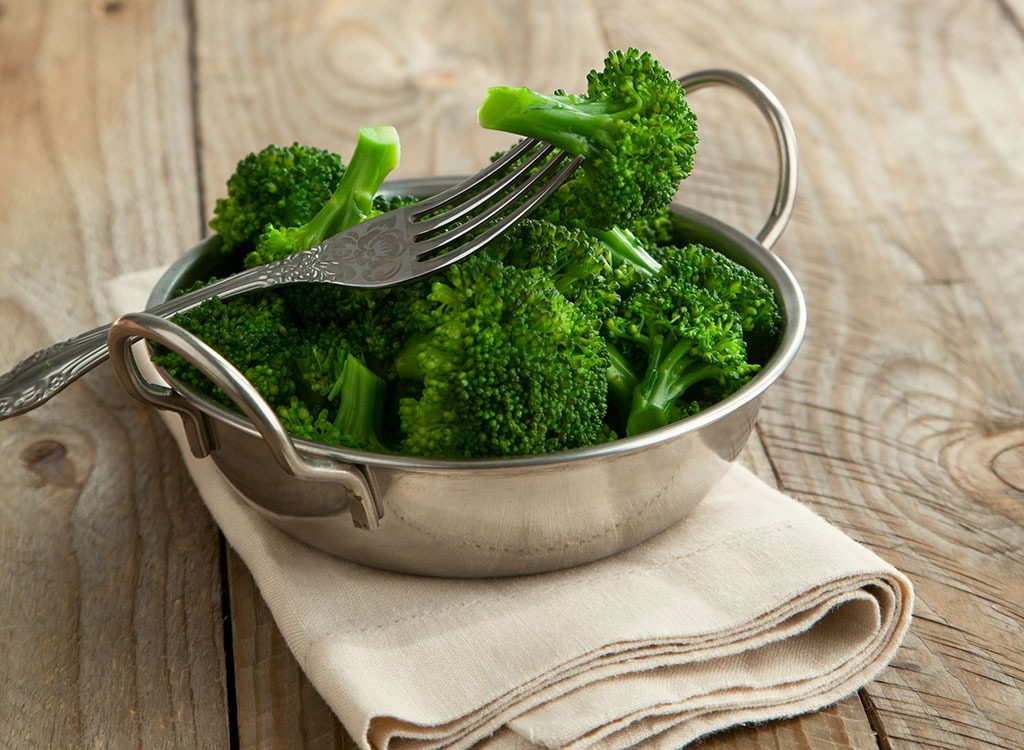
If cancer is a giant, complex circuit board, broccoli is like the big red OFF switch. Researchers attribute the anti-cancer properties primarily to sulforaphane (SPN), a powerful compound that works on a genetic level to effectively "switch off" cancer genes. But triggering its release is tricky, and too much cooking can damage myrosinase, the enzyme that is vital to the formation of this powerful antioxidant. Thankfully, researchers have figured out exactly how to maximize the cancer-fighting power of broccoli. It involves heating the florets just enough to eliminate a sulfur-grabbing protein that deactivates the vegetable's cancer-fighting properties, but not enough to kill the enzyme that helps to produce the powerful anti-carcinogenic compound.
Eat This! Tip:
According to the study, the best way to prepare broccoli is to steam it lightly over a bain marie (a fancy phrase for a hot water bath) about 3 or 4 minutes—until the broccoli is tough-tender. If you like your broccoli well done, but still want to reap the cancer-fighting SPN, other research recommends pairing it with mustard. Spicy foods like mustard, horseradish, and wasabi contain the enzyme (called myrosinase) that forms SPN but is destroyed by heat.
The same goes for: Sulforaphane foods like cauliflower, brussels sprouts, kale, and cabbage
Carrots: Boil
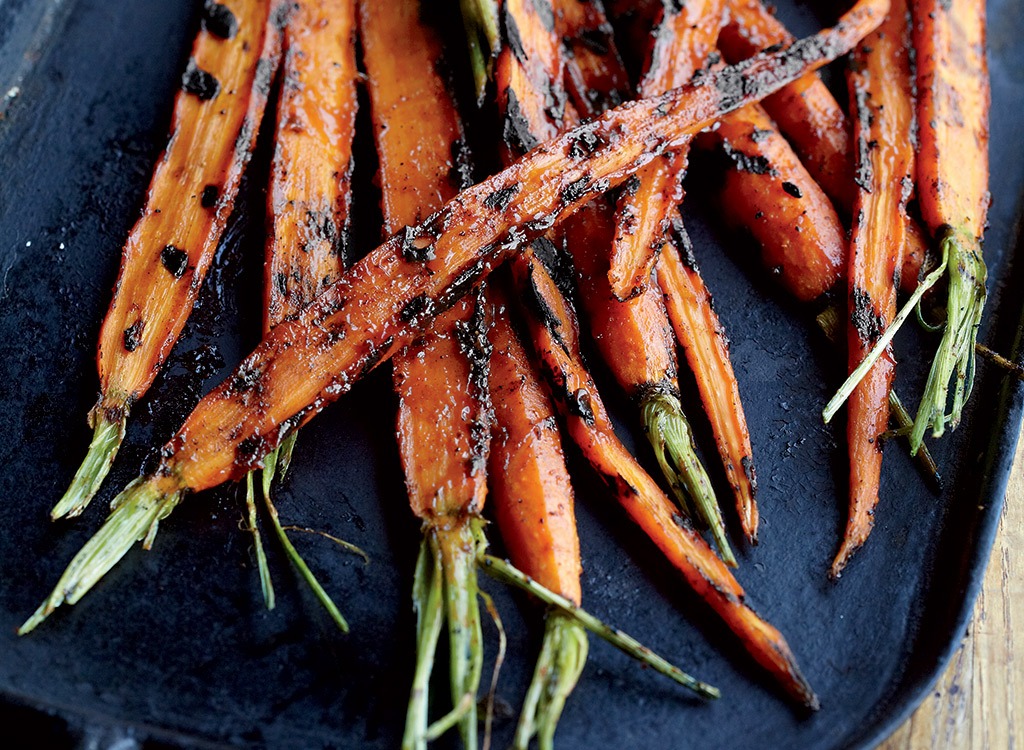
There's nothing better than the sweet, crispy crunch of a fresh carrot, but munching on this orange vegetable raw isn't the best way to get your daily dose of vitamins (like fiber). According to an International Food Research Journal report, boiling the orange vegetable allows the human body to extract a much larger fraction of its beta-carotene—a carotenoid that the body converts to immune-boosting, vision-protecting, and skin-glowing vitamin A—from the carrots' cell walls. The heat also helps to free the carotenoids from the protein complex in which they reside in the carrot.
Eat This! Tip:
Cook the carrots until soft, either by boiling or roasting them. To add a punch of flavor to your boiled carrots, drain and transfer them to a bowl and toss with a drizzle of olive oil and a bit of pepper and dried rosemary. Adding the oil makes them taste better, but also enhances the uptake of beta-carotene since it is a fat-soluble vitamin. Pureeing carrots also helps to break down cell walls so that the carotenoids are more available for absorption. Carrot soup or carrot cake, anyone?
The same goes for: Beta-carotene foods like sweet potatoes, squash, red peppers, peas, and broccoli
Spinach: Take Your Pick
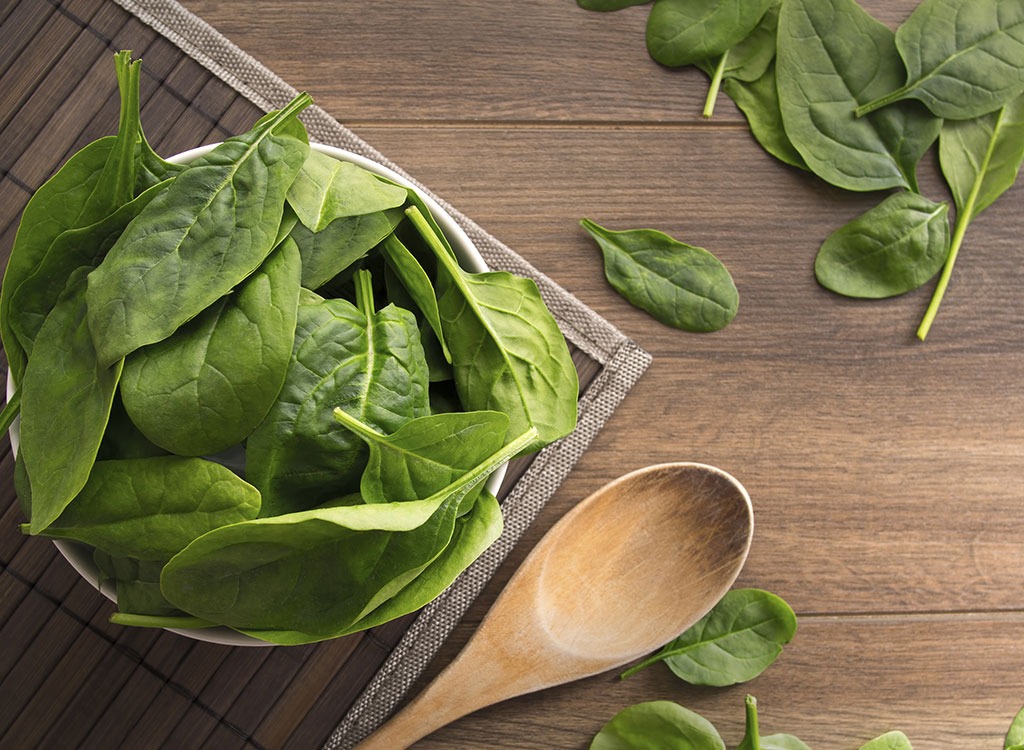
Spinach is a tricky veggie. On one hand, it's full of lycopene, beta-carotene, and lutein—all antioxidants found to become much more bioavailable and more easily absorbed by our bodies following the cooking process. It's full of iron, which cooking makes more available for absorption by decreasing oxalates, an acid that makes the minerals inaccessible by binding to them.
On the other, it's also a great source of vitamins A and C, B-vitamin folate, minerals such as hydrating potassium as well as bone-building calcium, magnesium, and manganese. Each is too easily destroyed when cooked.
Eat This! Tip:
From a nutrition standpoint, a combination of both raw and cooked spinach will provide you with the most health benefits. Either way, dress it with a little oil to boost your absorption of fat-soluble carotenoids and lutein.
Kale: Eat Raw

Many studies show that overcooking vegetables can actually break down their nutrients, making them significantly less healthful than their raw version. In particular, it's the foods that are high in water-soluble vitamins like vitamin C and the B vitamins that are the most heat-sensitive. A 90 g serving of kale provides you with 108 mcg folate, 99 mg vitamin C, and 117 mg of calcium (almost as same as a glass of milk!)—all significant contributions to your daily intake, but all micronutrients that can take a hit if cooked. In fact, around a third of the vitamin C in kale can be lost when it's boiled.
Eat This! Tip:
When you're eating it raw, make sure to cut it up well. Cutting fruits and vegetables that are raw generally frees up the nutrients by breaking down rigid plant cell walls. If cooking, make sure it's done at low heat and without too much water by steaming, sauteing, or roasting them. And add a drizzle of oil to absorb kale's lutein contents.
The same goes for: Vitamin B1 foods (sunflower seeds and beet greens), vitamin B6 foods (kale and avocado), vitamin B12 foods, i.e. folate (fish and shellfish (like clams), and vitamin C foods (bell peppers). In fact, according to research from the National Institutes of Health, a significant percentage of the vitamin C in bell peppers—totaling 150 percent of your DV—will break down if cooked above 375 degrees.
Zucchini: Boil

A report in the Journal of Agriculture and Food Chemistry examined the impact of the various cooking techniques on compounds such as carotenoids, ascorbic acid (vitamin C) and polyphenols (like the antioxidant quercetin) in zucchini. Researchers found that boiling actually increases the carotenoids and maintains levels of vitamin C in zucchini compared to when you fry or steam it. The researchers speculated it's because frying or steaming actually allows more light, oxygen, and is at a higher temperature than boiling—all factors which cause deterioration of these antioxidants.
Eat This! Tip:
While boiling still provides you with high percentages of beta carotene, it still decreases the amount of polyphenols in the zucchini. The simple fix? Leave the zucchini in the stock you boiled it in, which will now have all those water-soluble polyphenols, and make our favorite minestrone soup.
Garlic: Crush and Chop
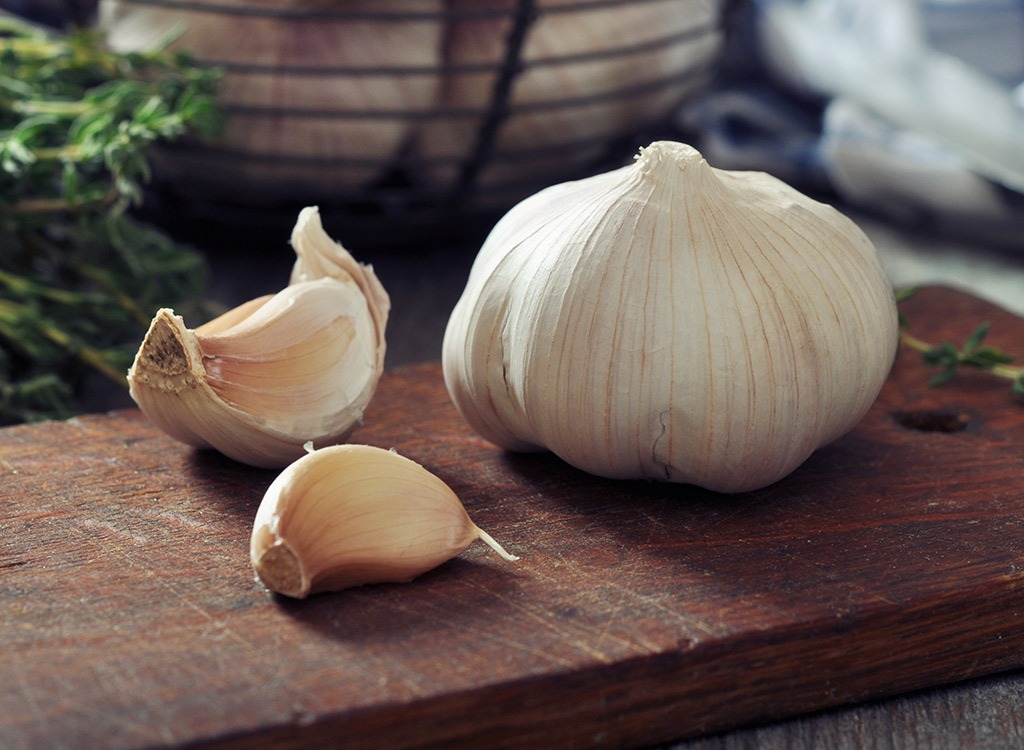
You know those glow-in-the-dark necklaces they pass out at block parties and the 4th of July? You snap them, some chemicals mix together, and then BAM! Glow sticks! Well, a similar thing happens when you crush garlic. Garlic contains allicin—the same compound that makes the clove a breath-killer—which acts as a wicked fat-burner and could have anti-cancer effects. The only catch? The precursor to allicin, alliin, is packed away from the enzyme that's necessary to turn it into the cancer-fighting version. By just smashing your clove of garlic, the enzyme and alliin mix, and you get allicin!
Eat This! Tip:
While one minute of cooking alliinase (the enzyme) completely inactivates it, allicin is relatively heat stable. So if you crush and chop your garlic and then wait around 10 minutes for the allicin to form, you can then cook it. If you want to keep it raw, add garlic to pestos, salsas, and homemade—not ultra-processed—salad dressings.
Bread: Toast It

Bread gets a bad rap as being a source of "empty calories" that spikes your blood sugar and causes your body to store fat. But a study published in the European Journal of Clinical Nutrition found that toasting bread can significantly lower its glycemic index—a measure of how your blood sugar rises in response to a certain food, with foods lower on the glycemic index being less likely to cause spikes associated with weight gain.
Eat This! Tip:
If you first freeze bread and then toast it, the amount of glucose that your blood absorbs after eating it is half the amount you absorb from fresh bread. (You are literally making bread more weight-loss friendly!) The researchers suspect that the starch molecules in the bread take on a different structure as a result of freezing, defrosting and toasting, which means your body has to work harder to break down the sugar.
Eggs: Poach
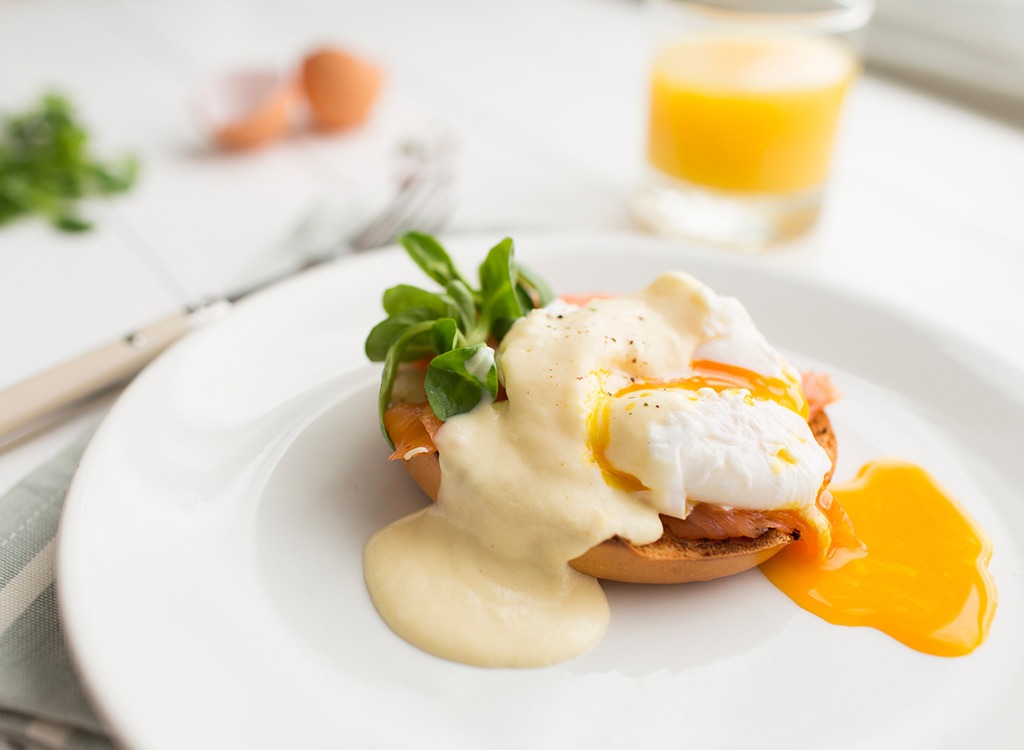
What's the healthiest part of the egg: the white or the yolk? We say both—and nutritionists agree. Because while the fat-free egg white contains most of the egg's satiating protein, it's the creamy yolk that contains all the essential fatty acids, disease-fighting nutrients and fat-soluble vitamins—including choline, a B-vitamin that helps prevent the accumulation of belly fat. Research shows maximizing the health value of an egg may come down to the cooking method:
Eat This! Tip:
While studies suggest cooked egg-white protein is more easily digested because it is already denatured, some research has found a raw or runny yolk contains up to 50 percent more nutrients than a cooked yolk that's been hard-boiled. The solution: poaching—a fat-free cooking method that involves cracking an egg into simmering water.
Pasta and Potatoes: Chill
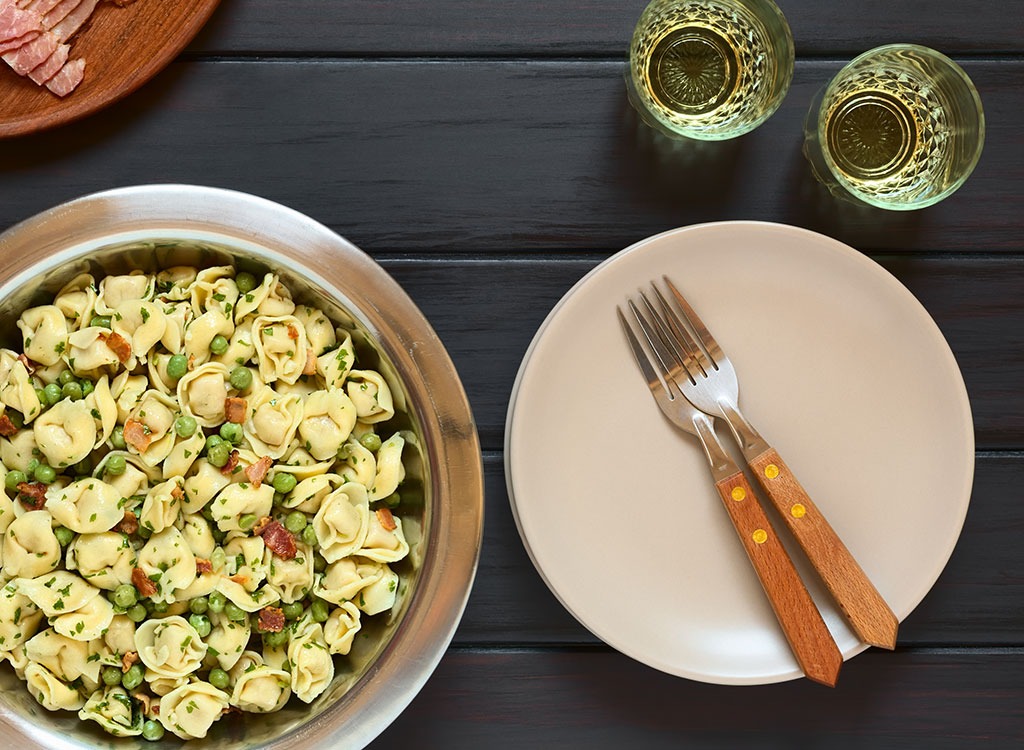
Did you know pasta can be a weight loss food? Well, cold pasta that is. The drop in temperature when you put pasta or potatoes in the fridge changes the nature of the starches into something called "resistant starch" proven to slow digestion and promote fat burning. Some natural resistant starches are lentils, peas, beans, and oatmeal, which pass through the small intestine intact, keeping you fuller, longer. Research suggests that including resistant starch with an evening meal can increase feelings of satiety by more than 50 percent, and also promote fat burning. Suffice it say, colder noodles = hotter you.
Eat This! Tip:
You can either whip up a cold pasta salad with fresh veggies and a light olive oil dressing or just heat up your leftovers! One experiment on the BBC show Trust me I'm a Doctor, conducted under supervision of Dr. Denise Robertson, a senior nutrition scientist from the University of Surrey, found leftovers could be even healthier than an original pasta meal. They were able to reduce a spike in blood glucose by 50 percent!
Berries: Buy Frozen or Eat Raw
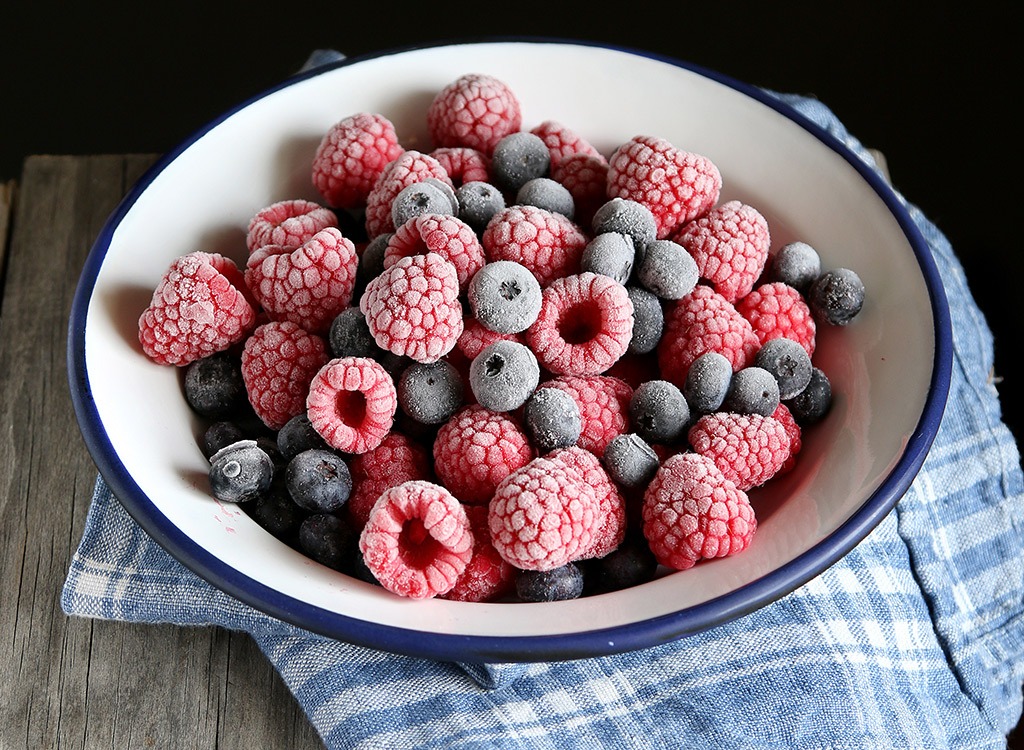
Blueberries pack a powerful antioxidant punch, and freezing the disease-fighting berries can make them even healthier, according to a South Dakota State University researcher. That's because anthocyanins, the health-boosting antioxidants that also give the berries their brilliant blue hue, are mostly found in the skin. The ice crystals that form during freezing pierce cell walls, allowing the anthocyanins to be more available. Cooking blueberries has the opposite effect, according to a study published in Journal of Agricultural and Food Chemistry that showed anthocyanin levels dropped by 10 to 21 percent after baking.
It's not just blueberries either. There are many Weight Loss Foods You Should Buy Frozen. When you pluck fruit from their source, they're cut off from their nutrient feed. The longer they're separated, the more nutritional value they lose. Some experts estimate that by the time you pick up a "fresh" fruit or vegetable at the grocery store, it may have lost 15-60 percent of many vitamins. And when produce is frozen, is frozen on the same day it's picked, preserving nutrition and antioxidants.
Eat This! Tip:
Buy your berries frozen to reap the benefits even if you want to break them open as soon as you get home. Frozen varieties are perfect in smoothies as well as to make fruit sauces to lay over ice cream.
Grilling?: Use a Grill Basket
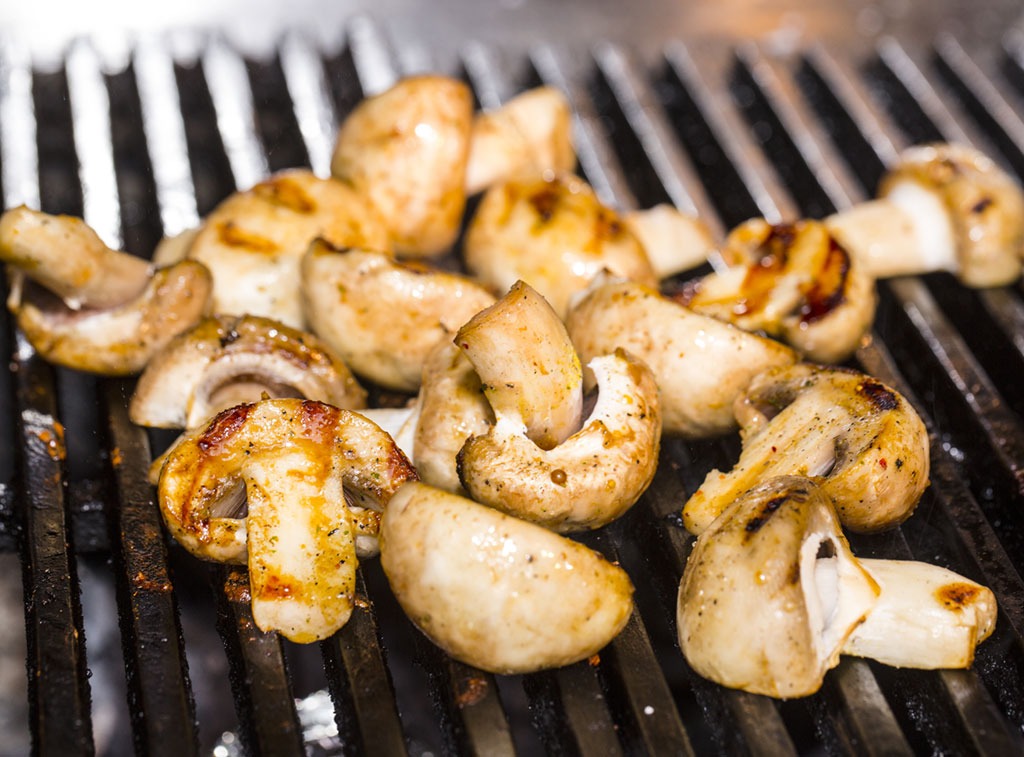
While you may love the slightly-burnt flavor that your grill lends to veggie kabobs, the hot and dry environment can deplete your produce's nutrients. What's worse, if you leave them on the grill long enough that they develop a blackened, charred appearance, that's a sign the veggies could have been exposed to benzopyrene, a carcinogenic chemical found in cigarette smoke. Another recipe for nutritional disaster? Slathering veggies in oil then cooking them over extra-high heat in an attempt to sit down to the dinner table sooner. When oil is exposed to extreme heat, it creates smoke that can break down the antioxidants in vegetables.
Eat This! Tip:
Next time you're BBQing outside, ditch the kabobs and cook your vegetables in a grill basket instead. This tactic eliminates the risk of consuming dangerous char, while helping the veggies retain their moisture, vitamins and minerals. Whipping up dinner indoors? Stick to medium-high cooking heat and skip the olive oil drizzle before heating your veggies. Cooking them dry and adding the fat after will help cut back on antioxidant-depleting smoke.
How to Prep
Grains and Pulses: Soak and Sprout
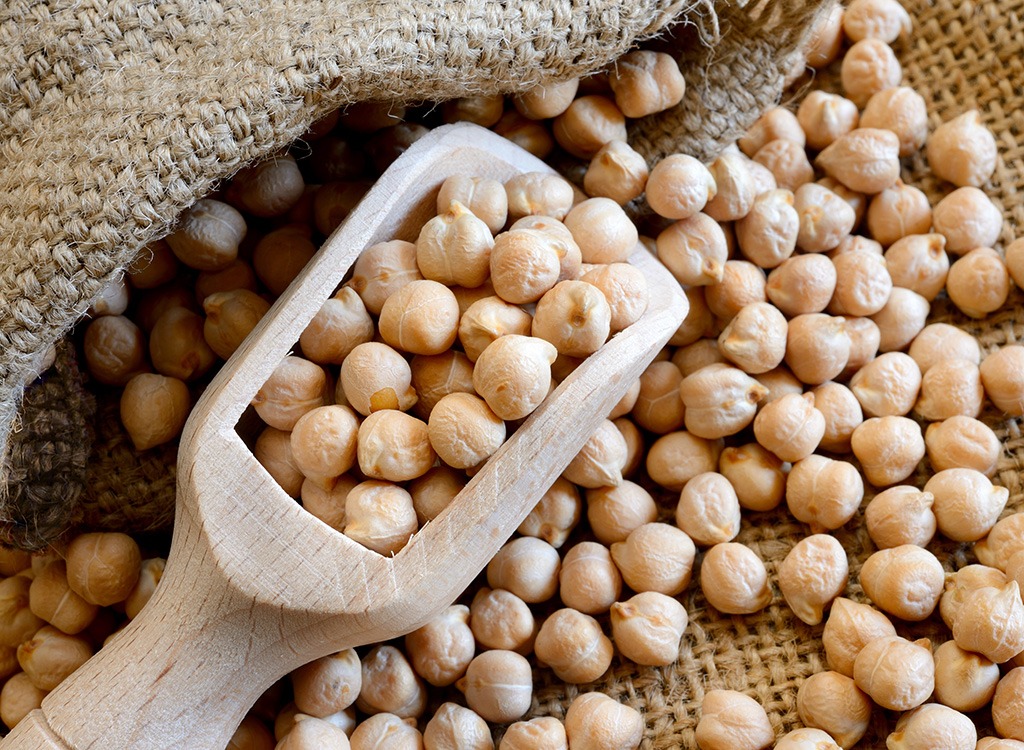
If you thought making you toot was bad, get a load of what else beans are doing to you. It turns out that pulses (beans, peas, and lentils), whole-grain cereals, and seeds are high in phytic acid. This evil compound binds to minerals such as iron, zinc, calcium, and magnesium, making them unavailable for absorption. When grains, beans, peas, and rices are sprouted, it reduces the phytic acid content to make its nutrients more bioavailable to the body. The sprouting seed also begins to release enzymes which break down protein and carbs, which help make these foods more easily digestible, allowing us to absorb typically lost nutrients. It doesn't stop there. The sprouting process apparent increases the amount and bio-availability of some vitamins (like Vitamin C) and minerals, making sprouted grains an even greater nutritional powerhouse.
Eat This! Tip:
According to the Weston A. Price Foundation, the best way to reduce phytates in beans is to sprout them and then cook them. They found that soaking pulses at moderate temperatures for 12 hours results in an 8-20 percent reduction in phytates. Too long and then the seed can fully sprout and lose its digestibility.
Strawberries: Eat Whole
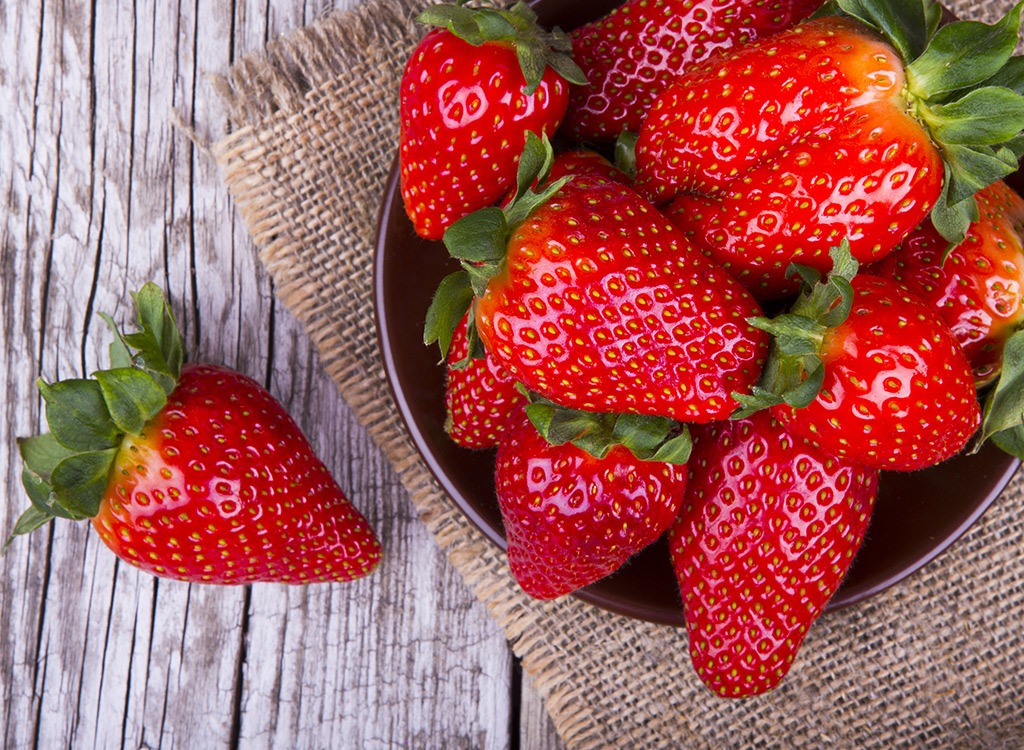
While you might be all about that meal prep life, you might be doing more harm than good. Slicing up strawberries exposes them to light and oxygen, which can break down their precious vitamin C! While this may be a bout of bad news, the fix is a simple one: just pop them in your mouth whole!
Eat This! Tip:
If necessary, wash and cut strawberries right before you use them. And to take in even more of their vitamin C, researchers suggest storing them in the refrigerator.
Kiwis: Eat The Skin
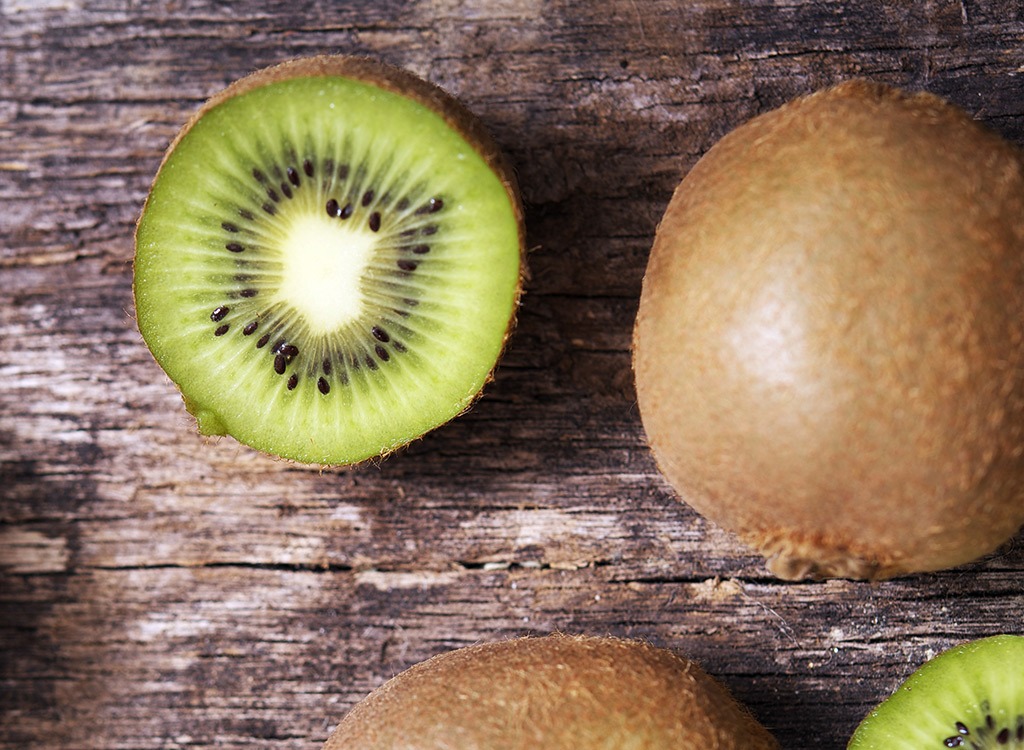
It may be brown and fuzzy, but don't let that turn you off. "The skin of kiwi fruits contain cholesterol-lowering fiber, antioxidants, and immune-boosting vitamin C," says Lisa Moskovitz, R.D., founder of The NY Nutrition Group. Just as your would rinse a peach or a pear to lower your exposure to pesticides and chemicals, washing kiwis is essential if you plan to bite right in.
Eat This! Tip:
More surprising news about this little green fruit: kiwis contain actinidine, an enzyme that breaks down protein, which makes them a great meat tenderizer. Instead of tossing older kiwis, use them to rub both sides of steak or poultry and then transfer the meat to a Ziploc bag for 20 minutes to give it time to absorb the juices and break down.
The same goes for: Cucumbers—if you remove the skin off your cucumbers, you're peeling away the very nutrients (like fiber and vitamin A) that make the veggie a health food powerhouse. The fibrous peel can help increase feelings of satiety, fueling your weight loss efforts.
Lemons and Limes: Keep the Peels
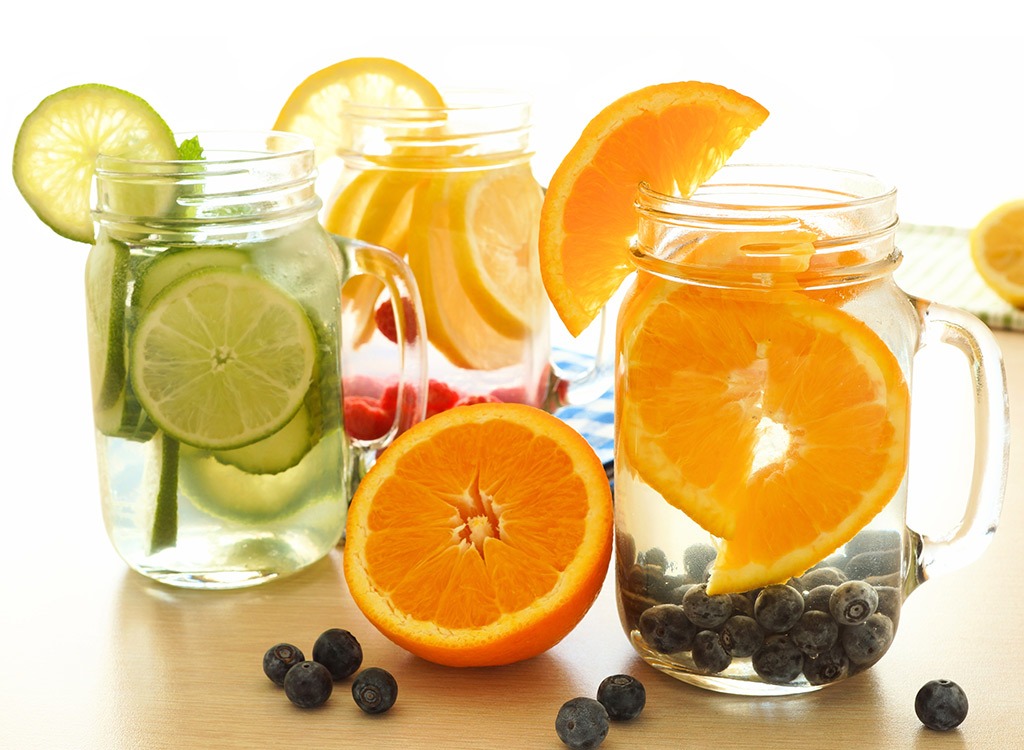
The citrus fruit peels provide you with a compound called d-limonene, a powerful antioxidant that stimulates liver enzymes, helping to rid the body of toxins and flush fat from your system. The only downside? There aren't too many appealing ways to eat it. Your best bet is to grate up the peels—the same way you'd do it with cheese—and store them in a freezer bag.
Eat This! Tip:
Throw slices of citrus fruit or just their peels into a pitcher of water to make your own detox water. If you're feeling a bit more adventurous, make your own citrus meat rub. Here's how: Dry tangerine or orange peels in a 200 degree F oven. Let them cool before chopping them very finely. Combine 1/4 cup of the dried peels with 2 tablespoons of salt and a tablespoon of black pepper.
Flax Seeds: Grind Them
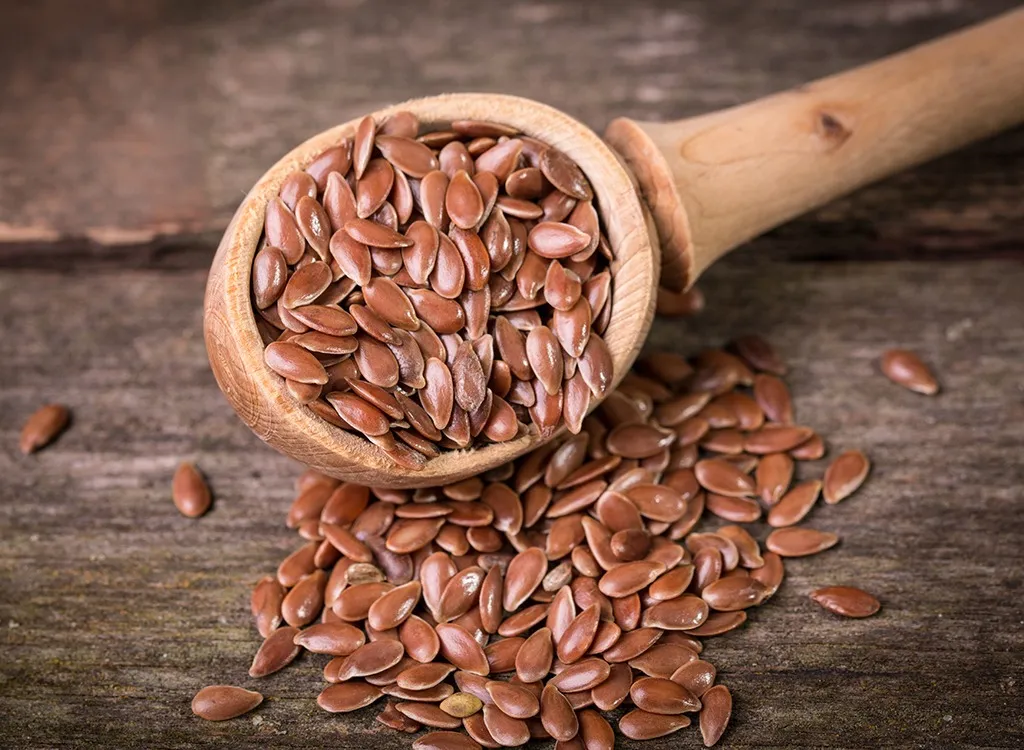
Flaxseed is a quality source of both important dietary staples, protein and fiber, as well as a plant-based source of anti-inflammatory omega-3s. But if you want to maximize these nutrients, you'll have to grind the flax seeds. Their hulls are so hard, eating flax seeds whole will result in them just passing through you undigested, and not passing off any of their benefits.
Eat This! Tip:
Don't fall for the pre-ground flax seeds, though. They'll lose their potency within 24 hours of being ground unless you keep them in the freezer. Your best bet is buying a bag of whole flax seeds and grinding them yourself as needed.
Tea: Microwave It
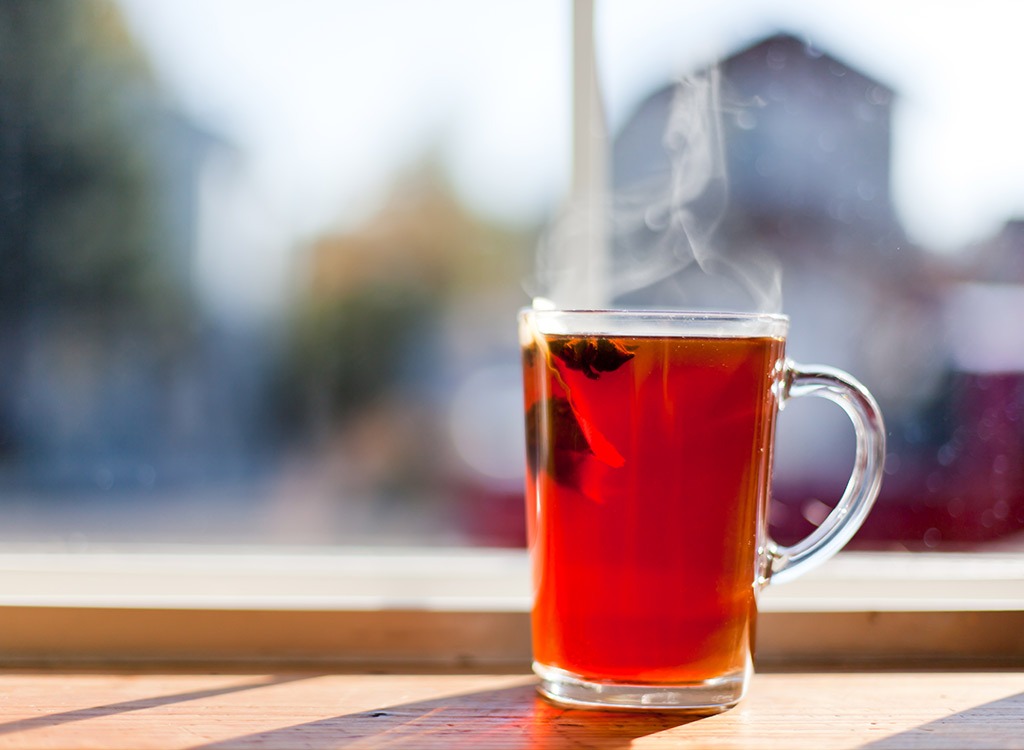
Tea is the closest thing we currently have to magic weight loss elixir. Rich in health-promoting compounds called catechins, regularly sipping the beverage can fry stubborn belly fat and even fight off disease. But if you want to reap the better-body benefits, zap your cup in the microwave.
Eat This! Tip:
After carrying out a series of preparation scenarios in a lab, researchers found that heating a brewed cup of tea in the microwave for one minute before enjoying could increase its catechin availability by nearly 20 percent. It also slightly boosted the caffeine content! Researchers warn the extra brew time may give tea a slightly more bitter taste and suggest fruit-infused green tea varieties that help mask the taste.
Fruits and Veggies: Blend Them
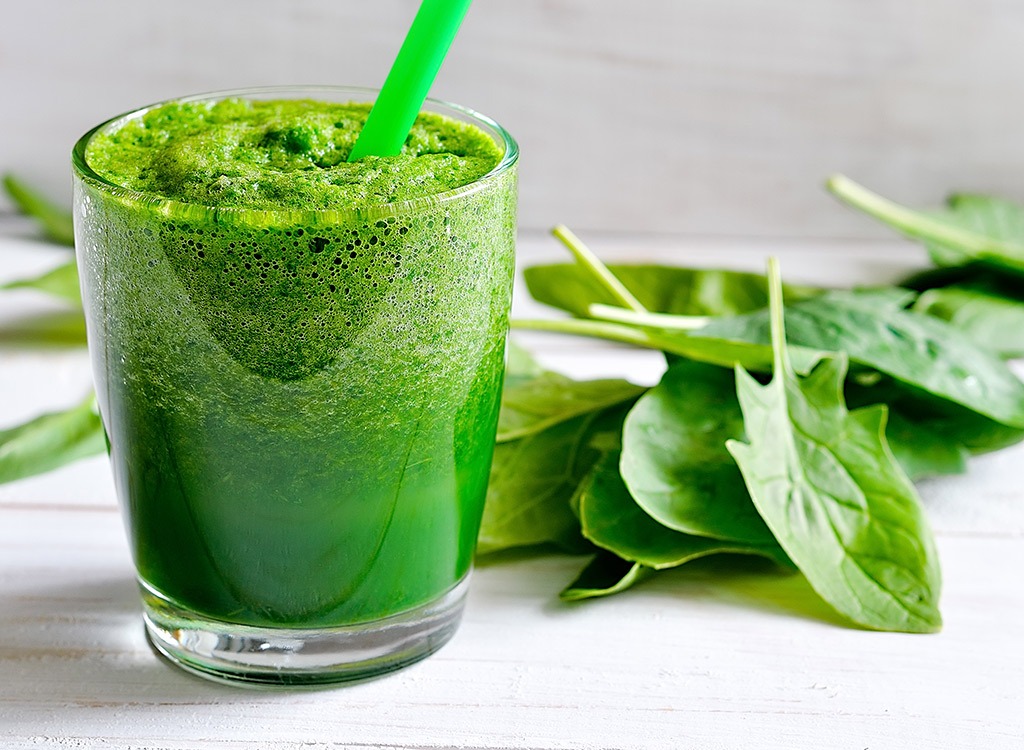
Yet another reason to love smoothies: you'll absorb even more nutrients! For one thing, smoothies act as more efficient chewers. Because blending helps break down fruit and veggies' hard-to-digest plant cell walls, your body has an easier time absorbing the nutrients compared to if were to chew every bite of your food until it turned to mush before you swallowed it. Plus, breaking down these cell walls allows the compounds that are physically separated in the cell normally—like enzymes stuck in the cell and their targets stuck within the cell walls—to mix and go through beneficial chemical reactions.
Eat This! Tip:
One of these snap-and-mix creations results in the formation of isothiocyanates, which have powerful anti-cancer properties and have been shown to inhibit tumor and cancer growth. They're found in foods like kale and watercress, which is why it's a good idea to add some greens to your smoothie. And we can't stress this enough: Blend, not juice. When produce goes through the juicing machine, its fiber-rich skins and pulp that help boost satiety get left behind.
How to Pair
Rice: Toss With Oil
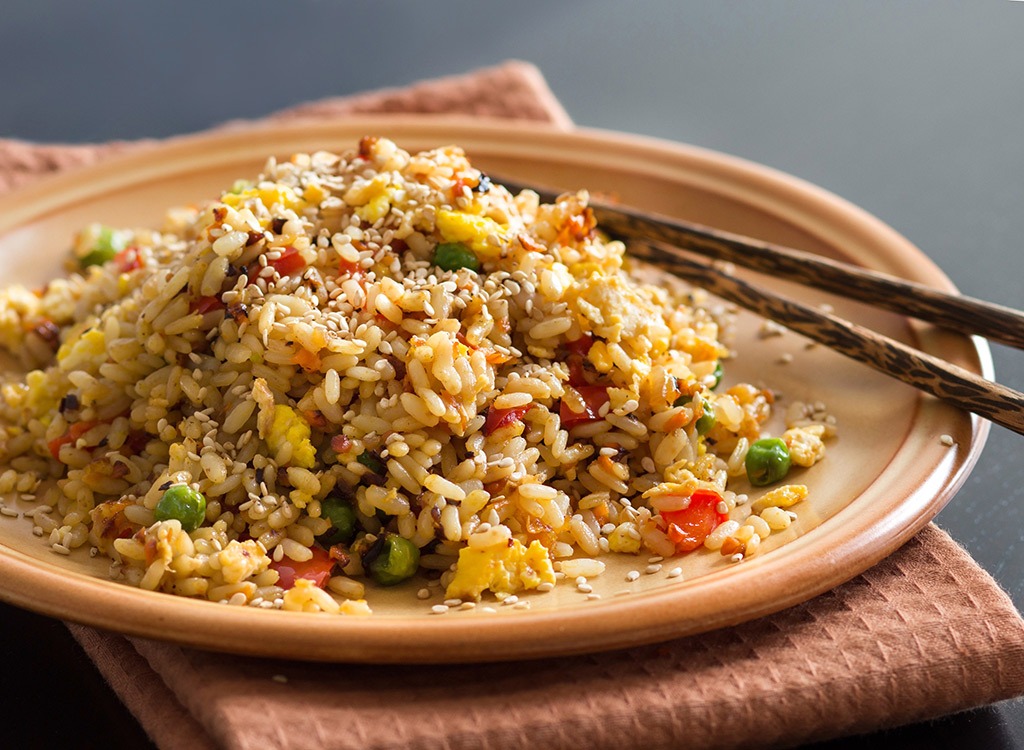
There's an easy, natural way to make rice less caloric; and, oddly enough, it involves adding fat. After numerous rounds of testing different rice varieties and cooking methods, researchers from the College of Chemical Sciences in Sri Lanka found the best way to cook rice. Their calorie hack works on two levels: Cooling the hot rice changes the nature of starch into a form that resists being broken down, and the added fat acts as a barrier against rapid digestion.
Eat This! Tip:
Boil a pot of water and drop a teaspoon of coconut oil. Add half a cup of rice and cook it for about 40 minutes. After cooking, stick it in the fridge for 12 hours. Rice cooked this way had at least 10 times the resistant starch and 10-15 percent fewer calories than normally prepared rice; and researchers think that with certain kinds of rice, the method could cut calories by 50-60 percent. The best news: the low-carb hack is safe for leftovers, as reheating the rice didn't affect the resistant starch levels.
Salad: Pair with Olive Oil or Avocado
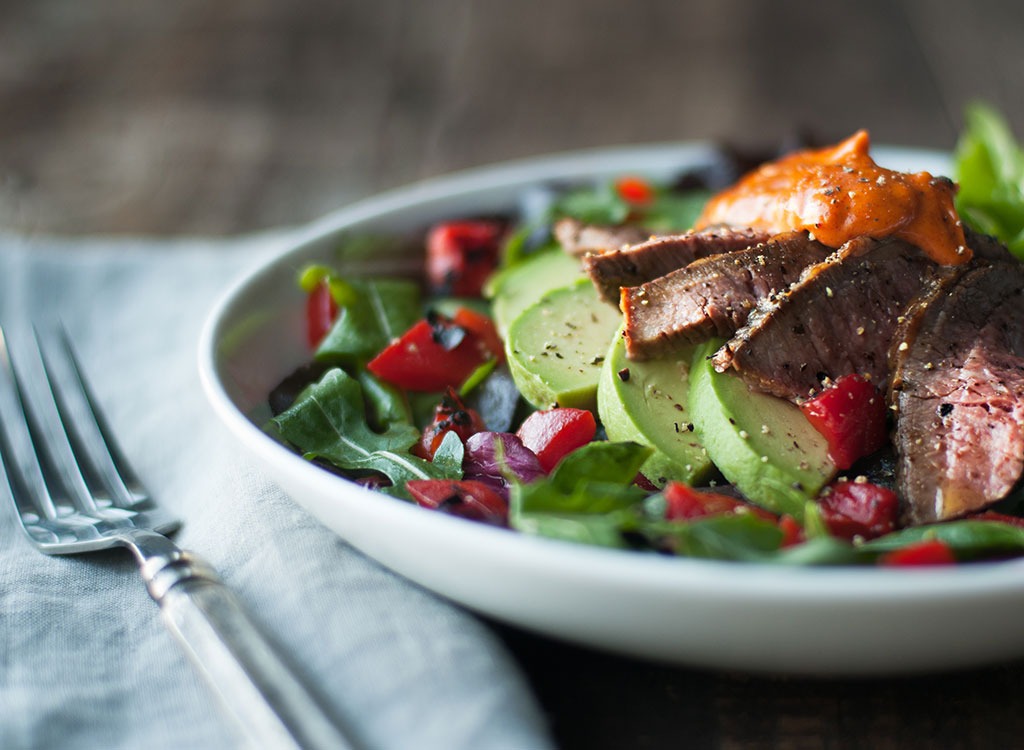
Low-calorie, vitamin-rich and chock-full of important nutrients that can shrink your waist, vegetables are a dieter's best friend; but you won't get much benefit from a garden salad without adding a little fat, researchers say. And the healthy fats found in olive oil reigns supreme. One study found that salads topped with olive oil monounsaturated fats required the least amount of dressing (only 3 grams) to get the most disease-fighting carotenoid absorption compared to polyunsaturated or saturated fat dressings (which required 20 grams for the same benefit). Another study found that when diners paired salsa or salad with fat-rich avocados, they absorbed as much as 4 times more lycopene, 7 times more lutein, and 18 times the beta-carotene than those who had their vegetables plain or with low-fat dressing.
Eat This! Tip:
Give your greens the ultimate nutrient boost with a light coating of extra virgin olive oil. Or, you can add a dollop of flavorful guacamole, a few slices of fresh avocado, or a tablespoon of avocado oil-based vinaigrette—avocadoes have the same healthy monounsaturated fats as olive oil does. Those dressing-on-the-side folks don't know what they're missing.
Turmeric: Pair With Black Pepper
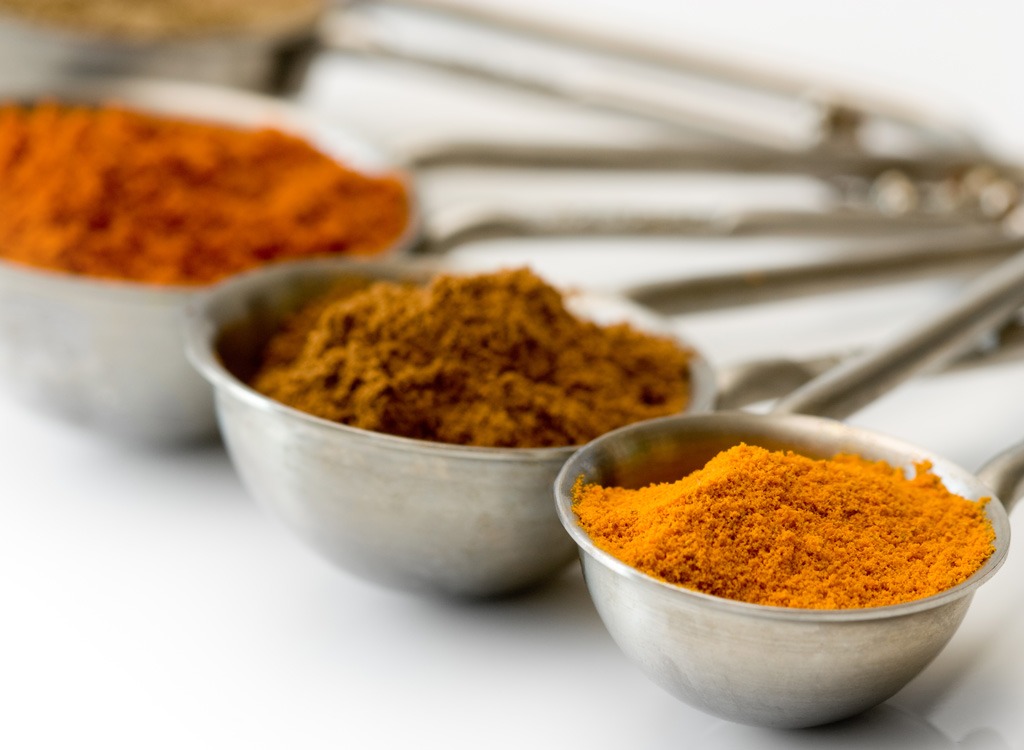
Even some spices need a little bioavailability boost. This is the case with curcumin, a bioactive phytochemical in turmeric that's been shown to have a wide spectrum of biological actions including as an anti-inflammatory, antioxidant, anticarcinogenic and anticancer agent. Unfortunately, it's notorious for not being readily absorbed by our bodies because most of the curcumin we consume is metabolized before we can enjoy its plethora of benefits.
Eat This! Tip:
According to a study by St. John's Medical college, eating turmeric with black pepper can boost curcumin's absorbability thanks to black pepper's piperine content. Piperine helps slow down the liver's metabolism of curcumin. These same benefits are what help black pepper stop the formation of new fat cells, making it an essential food to help you get beach-body ready.
Create a curry powder with turmeric, freshly ground black pepper, cumin, cardamom, coriander, dry mustard, and a little cayenne pepper. Use it to season chicken and serve with a side of rice and some veggies like onions, cauliflower, and zucchini.
Cocoa: Pair With Baking Powder
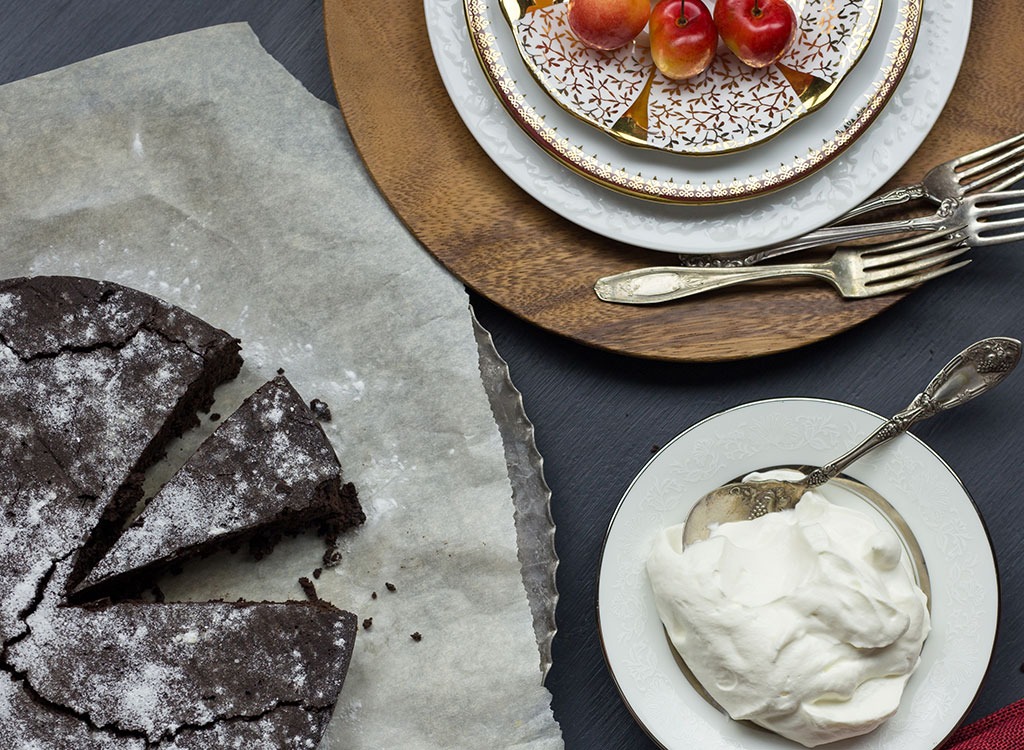
We love a slice of chocolate cake as much as the next guy, but we love a slice of chocolate cake that reduces our risk for heart disease and boosts our brain power even more. And that's what makes this healthy baking hack particularly sweet. A study published in the Journal of Food Science showed that using a combination of baking powder and baking soda could retain over 85 percent of cocoa's heart-protective flavanols otherwise lost in the hot baking process.
Eat This! Tip:
Partially substitute baking powder for the baking soda. The combo resulted in a lofty, attractive cake that preserved almost all of the health-promoting flavanols and antioxidants.
Steak or Spinach: Pair with Tomatoes
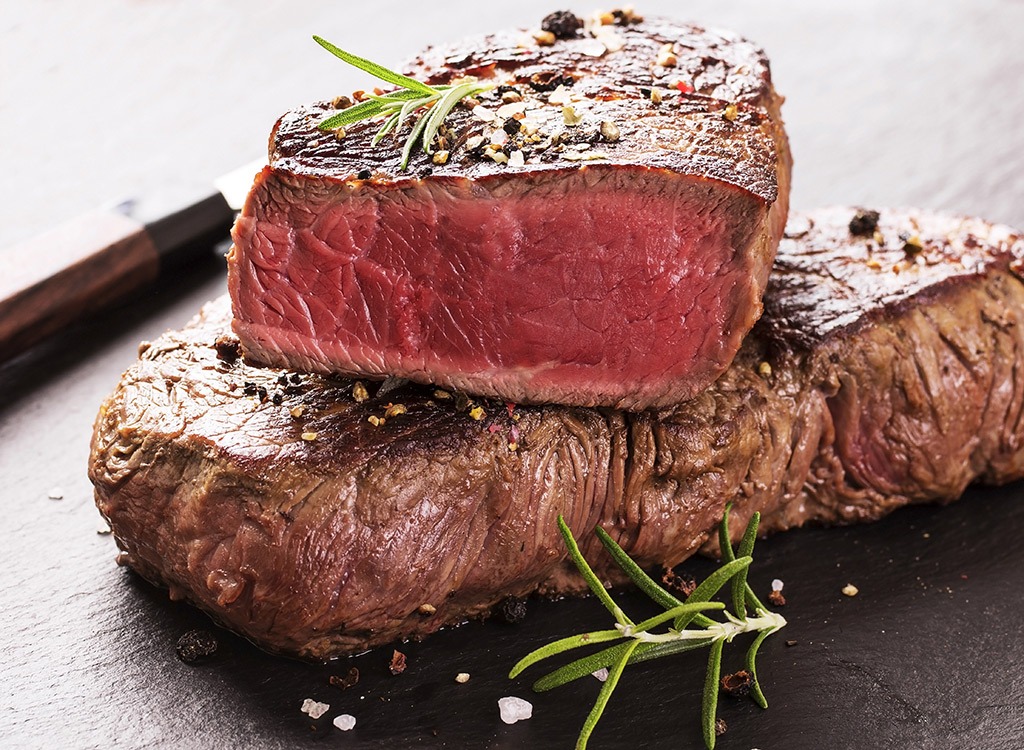
And not green tea. Curious combination, but we'd figure we'd warn you. According to a recent study, the iron in meat and plant-based sources like spinach don't play nicely with the antioxidants in green tea. Polyphenols bind with iron in the intestines, preventing the mineral from getting absorbed and causing it to pass out as waste instead. Vitamin C, on the other hand, can block these dietary compounds that inhibit absorption. Not only that, but it helps enhance the bioavailability of plant-based sources of iron—aka non-heme iron, the less potent form compared to animal-based heme iron—by up to 6 times more than without the vitamin.
Eat This! Tip:
Whether you're eating steak, spinach, kale, or lentils (all great sources of iron), make sure you pair them with vitamin-C-rich foods like tomatoes, lemon juice, strawberries, or chili peppers.
Asparagus: Pair With Salmon
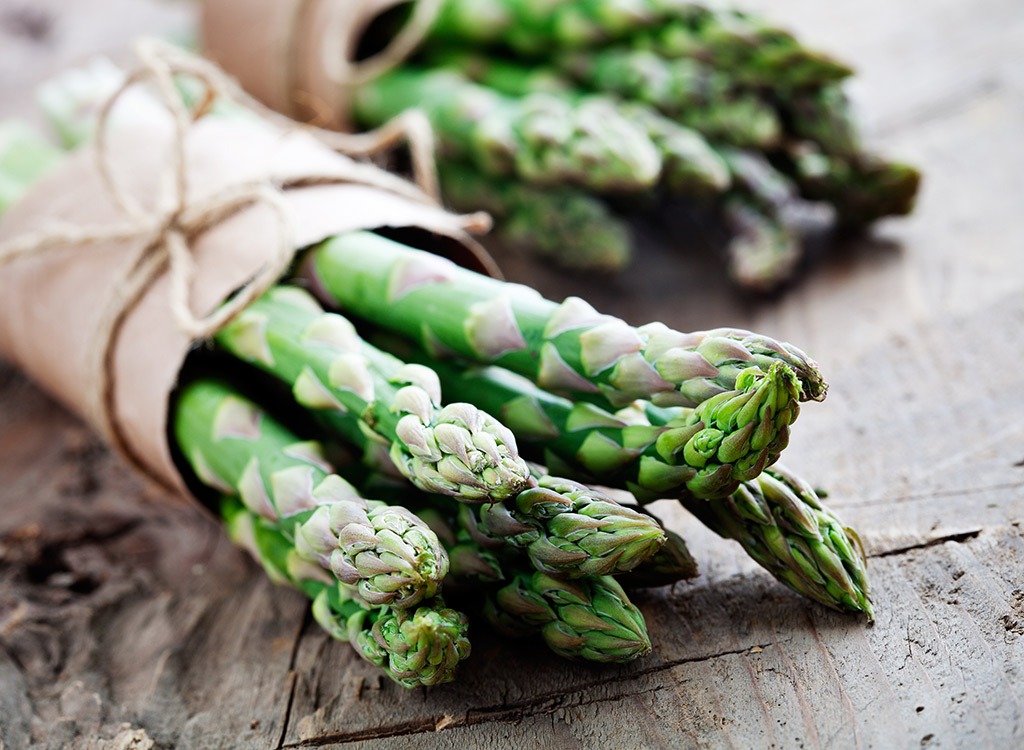
If you're trying to stick to a low-fat diet, you may be doing your health a disservice. According to Iowa and Ohio State University researchers, pairing a little bit of fat with red, yellow, orange and dark-green vegetables helps the body absorb cancer-fighting and heart-healthy nutrients like lycopene and beta-carotene as well as fat-soluble vitamins A, D, E, and K. Study findings show that you'll need to consume six grams of added fat with your veggies to reap the maximum nutritional benefits. That's less than half a tablespoon of olive oil!
Eat This! Tip:
Pair your veggies with healthy sources of fat. Vitamin A foods (sweet potatoes, carrots, squash), vitamin D foods (eggs, mushrooms), vitamin E foods (spinach and asparagus), and vitamin K foods (kale, spinach, and broccoli) should be balanced out with healthy fats like olive or coconut oil, avocado, fatty fish, nuts, or full fat yogurt.
